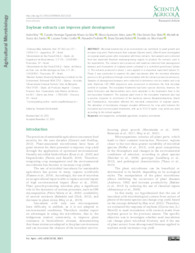Soybean extracts can improve plant development.
Soybean extracts can improve plant development.
Author(s): MAY, A.; SILVA, E. H. F. M. da; VIEIRA JUNIOR, N. A.; VILELA, E. S. D.; SANTOS, M. de S.; COELHO, L. F.; PEDRINHO, A.; BATISTA, B. D.; VIANA, R. da S.
Summary: Abstract: Microbial biodiversity of an environment can contribute to plant growth and increase crop yield. Plant extracts from soybean (Glycine max (L.) Merrill) were investigated on soybean plants grown after inoculation with these extracts. Soil samples were collected from two important Brazilian soybean-growing regions to produce the extracts used in the experiments. The extracts were produced with material collected from aboveground biomass and rhizosphere of soybean plants cultivated in a controlled greenhouse (phase 1). The extracts produced in phase 1 were applied in a sequential experiment (phase 2). Phase 2 was conducted to examine the plant microbiome after the microbial alteration process in the greenhouse through seed inoculation with the extracts produced previously. Samples of aboveground biomass were collected to determine root dry matter and crop yield. Bacterial 16S rRNA sequences were processed to determine the final microbial content of soybean. The inoculated treatments had lower species diversity; however, the phyla Firmicutes and Bacteroidetes were more abundant in the treatments than in the non-inoculated treatment. The soybean plant stem in the inoculated treatment also had a positive response to enrichment of the bacterial classes Betaproteobacteria, Bacilli and Flavobacteria. Inoculation affected the microbial composition of soybean plants. The alteration of microbiome changes revealed differences for crop yield between the inoculated and non-inoculated treatments, with up to 93.5 % higher crop yields per plant according to the extract applied.
Publication year: 2023
Types of publication: Journal article
Unit: Embrapa Environment
Observation
Some of Embrapa's publications are published as ePub files. To read them, use or download one of the following free software options to your computer or mobile device. Android: Google Play Books; IOS: iBooks; Windows and Linux: Calibre.
Access other publications
Access the Agricultural Research Database (BDPA) to consult Embrapa's full library collection and records.
Visit Embrapa Bookstore to purchase books and other publications sold by Embrapa.

